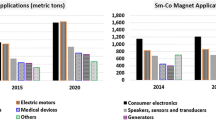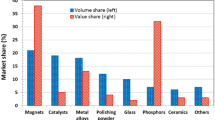Abstract
NdFeB permanent magnets are the best available magnets used in many technology applications. However, at their end-of-life (EoL) most of magnets and the contained REEs are lost during the recycling of the bulk metals. The REEs are classified as the most critical raw materials in the European Union, and recycling of REEs from EoL products will reduce their criticality and contribute to the sustainability of REE. Various technological routes have been reported, but most of the methods are effective for highly concentrated magnets or magnet scrap, which is greatly dependent on expensive pre-dismantling processes. This paper presents various innovative metallurgical solutions to the effective REE recovery from current industrial practice for WEEE recycling , including the ferrous scrap from WEEE shredder products and shredder residues from computer hard disk drives. Both hydrometallurgical and combined hydro- and pyrometallurgical REE recovery routes are developed after demagnetization and physical upgrading.
Access this chapter
Tax calculation will be finalised at checkout
Purchases are for personal use only
Similar content being viewed by others
References
Alonso E et al (2012) Evaluating rare earth element availability: a case with revolutionary demand from clean technologies. Environ Sci Technol 46:3406–3414. https://doi.org/10.1021/es203518d
Nansai K et al (2014) Global flows of critical metals necessary for low-carbon technologies: the case of neodymium, cobalt, and platinum. Environ Sci Technol 48(3):1391–1400. https://doi.org/10.1021/es4033452
Goodenough KM, Wall F, Merriman D (2018) The rare earth elements: demand, global resources, and challenges for resourcing future generations. Nat Resour Res 27(2):201–216. https://doi.org/10.1007/s11053-017-9336-5
Gemechu ED et al (2016) Import-based indicator for the geopolitical supply risk of raw materials in life cycle sustainability assessments. J Ind Ecol 20(1):154–165. https://doi.org/10.1111/jiec.12279
European Commission (2017) Report on the critical raw materials for EU, report of the Ad hoc working group on defining critical raw materials. European Commission, Enterprise and Industry, Brussels
Sprecher B et al (2017) Novel Indicators for the quantification of resilience in critical material supply chains, with a 2010 rare earth crisis case study. Environ Sci Technol 51(7):3860–3870. https://doi.org/10.1021/acs.est.6b05751
Nlebedim IC, King AH (2018) Addressing criticality in rare earth elements via permanent magnets recycling. JOM 70(2):115–123. https://doi.org/10.1007/s11837-017-2698-7
Gutfleisch O et al (2011) Magnetic materials and devices for the 21st century: stronger, lighter, and more energy efficient. Adv Mater 23(7):821–842. https://doi.org/10.1002/adma.201002180
Schüler D, Buchert M, Liu R, Dittrich S and Merz C (2011) Study on rare earths and their recycling—final report for the Greens/EFA Group in the European Parliament, Öko-Institute e.V
Moss RL et al (2011) Critical metals in strategic energy technologies: assessing rare metals as supply-chain bottlenecks in low carbon energy technologies. Eur Comm JRC Inst Ener Transp. https://doi.org/10.2790/35716
Binnemans K et al (2013) Recycling of rare earths: a critical review. J Clean Prod 51:1–22. https://doi.org/10.1016/j.jclepro.2012.12.037
Yang Y et al (2017) REE recovery from end-of-life NdFeB permanent magnet scrap: a critical review. J Sustain Metall 3(1):122–149. https://doi.org/10.1007/s40831-016-0090-4
Vander Hoogerstraete T et al (2014) From NdFeB magnets towards the rare-earth oxides: a recycling process consuming only oxalic acid. RSC Adv 4(109):64099–64111. https://doi.org/10.1039/C4RA13787F
Önal MAR et al (2017) Recycling of NdFeB magnets using nitration, calcination and water leaching for REE recovery. Hydrometallurgy 167(1):115–123. https://doi.org/10.1016/j.hydromet.2016.11.006
Önal MAR et al (2015) Recycling of NdFeB magnets using sulfation, selective roasting, and water leaching. J Sustain Metall 1(3):199–215. https://doi.org/10.1007/s40831-015-0021-9
Lyman JW, Palmer GR (1993) Recycling of rare earths and iron from NdFeB magnet scrap. High Temp Mater Process (London) 11(1–4):175–187. https://doi.org/10.1515/HTMP.1993.11.1-4.175
Massari S, Ruberti M (2013) Rare earth elements as critical raw materials: focus on international markets and future strategies. Resour Policy 38(1):36–43. https://doi.org/10.1016/j.resourpol.2012.07.001
Abrahami ST, **ao Y, Yang Y (2015) Rare-earth elements recovery from post-consumer hard-disc drives. Miner Process Extr Metall 124(2):106–115. https://doi.org/10.1179/1743285514Y.0000000084
Venkatesan P, Sun Z, Sietsmaa J, Yang Y (2018) An environmentally friendly electro-oxidative approach to recover valuable elements from NdFeB magnet waste. Sep Purif Technol 191:384–391. https://doi.org/10.1016/j.seppur.2017.09.053
Yang Y, Wang X, Wang M (2015) Recovery of iron from red mud by selective leach with oxalic acid. Hydrometallurgy 157:239–245. https://doi.org/10.1016/j.hydromet.2015.08.021
Venkatesan P et al (2018) Selective electrochemical extraction of REEs from NdFeB magnet waste at room temperature. Green Chem 20(5):1065–1073. https://doi.org/10.1039/C7GC03296J
Acknowledgements
The research presented in this paper has received the funding from the two EU FP7 funded projects MC-ITN EREAN (project no. 607411) and REEcover (project no. 603564), as well as the industrial funding from Van Gansewinkel Group (now Renewi) in the Netherlands.
Author information
Authors and Affiliations
Corresponding author
Editor information
Editors and Affiliations
Rights and permissions
Copyright information
© 2018 The Minerals, Metals & Materials Society
About this paper
Cite this paper
Peelman, S., Venkatesan, P., Abrahami, S., Yang, Y. (2018). Recovery of REEs from End-of-Life Permanent Magnet Scrap Generated in WEEE Recycling Plants. In: Davis, B., et al. Extraction 2018. The Minerals, Metals & Materials Series. Springer, Cham. https://doi.org/10.1007/978-3-319-95022-8_221
Download citation
DOI: https://doi.org/10.1007/978-3-319-95022-8_221
Published:
Publisher Name: Springer, Cham
Print ISBN: 978-3-319-95021-1
Online ISBN: 978-3-319-95022-8
eBook Packages: Chemistry and Materials ScienceChemistry and Material Science (R0)




